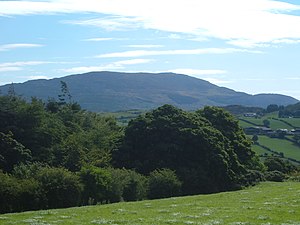Slieve Gullion
| Slieve Gullion | |||
| County Armagh | |||
|---|---|---|---|
 Slieve Gullion from Aughanduff | |||
| Range: | Ring of Gullion | ||
| Summit: | 1,880 feet J024201 54°7’15"N, 6°25’59"W | ||
Slieve Gullion is a mountain in the south of County Armagh. The mountain forms the core of the Ring of Gullion and stands as the highest point in the county, rising to 1,880 feet above sea level.
Slieve Gullion plays a prominent role in the Irish mythology and history of the area surrounding it and dominates the countryside around it, offering views of as far away as Connaught and Dublin Bay in favourable weather conditions.
The mountain's name derives from the Gaelic language: Sliabh gCuillinn means "Mountain of the hillslopes".[1][2]
Slieve Gullion lends its name too to the surrounding countryside of County Armagh.
Form of the hill
Slieve Gullion is the eroded remains of a Paleocene volcanic complex. It is surrounded by a ring dyke. Slieve Gullion has been shaped by glaciation and exhibits a classic 'crag and tail' glacial feature. The 'tail', composed of glacial deposits, points south, ending at Drumintee. At the top of the mountain is a tarn, Calliagh Berras Lough.
Two cairns exist on top of the mountain on either side of the tarn of which the northern cairn is a circular mound of stones approximately 40 feet in diameter whilst the southern one, known as Calliagh Birra’s House, is a large, well preserved passage grave which is the highest yet discovered in Ireland.[3]
Much of the surface of Slieve Gullion is covered with forest, heather, or raw stone while an amount of 1,512 acres of dry heath on the mountain have been designated a Special Area of Conservation,[4] an Environmentally Sensitive Area,[5] and an Area of Outstanding Natural Beauty. In July 2006, some areas of gorse was destroyed by a wildfire which might have been started deliberately.[6]
Traces of fields on the mountain's poor soil from farming in earlier times can still be seen as well as evidence of quarrying. Today Slieve Gullion is barely farmed but is popular with visitors and trekkers with scenic road access up to about half of the mountain's elevation and remains of an old trail allowing easy access to the summit. Drumintee, Mullaghbawn, Lislea, Forkhill and Meigh lie in Slieve Gullion's immediate hinterland.
In mythology

The mountain features in the epic poem Táin Bó Cuailnge. It is also suggested that this is the area where Cuchullain lived as a child. There are many local legends about Slieve Gullion involving the Cailleach Beara (a witch who transforms into a hare).
Slieve Gullion also features in the Fenian Cycle, where a tale is told of Finn McCool being tricked by the Cailleach Beara into jumping into the mountain's lake, from which he emerges an old and withered man. The Fianna force the Cailleach Beara to restore the erstwhile hero back to his former self but Finn never regains the true colour of his hair; it remains as white as an old man's for the rest of his life.
Outside links
- Slieve Gullion forest park
- Slieve Gullion, Co. Armagh: A mythical mountain with two cairns on the summit
- A virtual-reality tour of Slieve Gullion and its monuments
References
- ↑ 'Cuileann in áitainmneacha' by T.S.Ó Máille in 'Béaloideas' The Journal of the Folklore of Ireland Society. XXV111 1960.
- ↑ Placenames Database of Ireland
- ↑ [1]
- ↑ Slieve Gullion Special Area of Conservation
- ↑ Environmentally Sensitive Areas (Slieve Gullion) Designation (Amendment) Order (Northern Ireland) 1997
- ↑ Arsonists Strike 2,500 Times In Ulster In Last Three Years